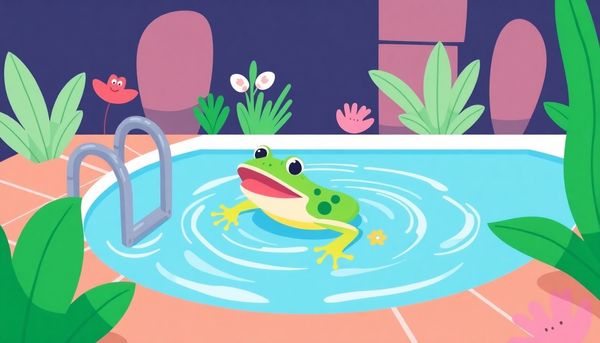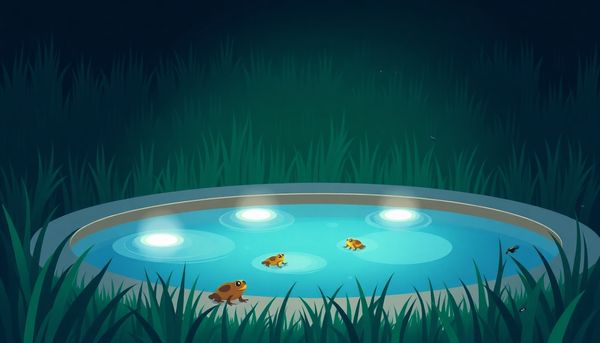Keep Frogs Out of Your Pool: Effective Strategies for a Peaceful Swim
July 13th, 2024
July 13th, 2024
On warm summer evenings, the rhythmic chorus of frogs can be a soothing soundtrack to your backyard relaxation. However, when those amphibious guests decide to take a dip in your swimming pool, the peaceful ambience quickly turns into a cleanup chore. I recall one summer when my own pool became a popular hangout for these unexpected visitors, transforming it into a mini wetland oasis. Managing this frog invasion soon became an urgent task.
Understanding why frogs find pools so inviting is the first step to keeping them at bay. Often, they mistake the tranquil, shimmering water for a natural pond, perfect for cooling off or laying eggs. The bright pool lights and the promise of a safe refuge from predators only add to their allure. Left unchecked, they can introduce unwanted debris and potentially harmful bacteria to your pool, not to mention startling the occasional unsuspecting swimmer.
Preventing frogs from making your pool their temporary home requires a mix of practical strategies and a bit of creativity. It’s not just about making the water less appealing but also thinking about the surrounding environment that encourages their presence. From adjusting the lighting to creating barriers, the solutions are varied and often surprising in their effectiveness. By exploring these methods, you can reclaim your pool as a peaceful spot for human enjoyment, free from the froggy fanfare.

Frog-proof barriers can be your pool's first line of defense against unwanted amphibian visitors. Consider them the bouncers of your backyard oasis, keeping the froggy party firmly outside. A solid barrier doesn't just mean any fence; it means the right fence. Opt for wooden or vinyl fencing that reaches the ground, leaving no gaps for frogs to squeeze through. Unlike their chain-link or wrought-iron counterparts, these barriers offer no easy passages for the nimble jumpers.
Finding the right fence height is crucial. While frogs aren't Olympic high jumpers, a fence should still be at least two feet high, ensuring they can't simply hop over it. Think about the ground as well. Installing the fence with a slight underground extension can deter burrowing attempts by other pesky critters looking to join the poolside fun.
Moreover, positioning is key. Placing the fence a few feet away from the pool's edge prevents ambitious frogs from making a splash with a long jump. For added protection, you might also want to try adding a mesh netting at the top, a tactic reminiscent of the nets used in protecting gardens from birds. It’s an eco-friendly measure that respects the local wildlife while maintaining a serene, frog-free pool environment.
In my own backyard, a simple wooden fence made all the difference. Gone were the days of unexpected frog encounters during evening swims. The peace of mind was worth every plank and nail, turning our pool into a peaceful, exclusive retreat.
While you might think of your pool as a summer oasis, frogs see it as a delightful, albeit deceptive, pond. Keeping these amphibians at bay can be a challenge, but choosing the right type of fencing can make all the difference. My neighbor once turned their backyard into a mini frog preserve by installing the wrong type of fence. Frogs laughed in their throaty way as they hopped through the gaps of an ornate iron fence. It was a learning curve for all of us.
To effectively deter these jumpy visitors, opt for a solid material. Vinyl or wood fencing acts as a barrier, preventing frogs from sneaking into your pool for an unintended swim meet. When selecting a fence, consider its height and ensure that it extends below ground level to stop the most determined hoppers who might try to dig underneath.
If aesthetics are a concern, there are decorative options in solid fencing that blend seamlessly with backyard designs. Also, consider installing a gate with a secure latch, as frogs are surprisingly persistent and might find any opportunity to slip through unsecured spots.
Fencing not only keeps frogs at bay but also adds a layer of safety for children and pets. So, when tailoring your poolside sanctuary, remember: a well-chosen fence could save you from the surprise of an amphibian pool party that no one ever RSVPed to.
In the quest to keep your backyard pool frog-free, pool covers can be your unsung heroes. They act as a barrier, transforming your inviting water into a no-entry zone for these amphibians. Life as a pool owner often means battling the elements, whether it's leaves in the fall or debris after a storm. Adding frogs to that list isn't ideal, but a well-fitted pool cover can prevent the amphibian invasion.
A pool cover isn't just a protective sheet; it's a versatile tool that keeps unwanted visitors out while maintaining your pool's cleanliness. Consider the classic option of a standard pool cover, which can be snugly fitted over your pool each night or whenever it's not in use. This simple action not only deters frogs but also keeps insects at bay, cutting off the food supply that attracts frogs in the first place.
For those seeking an extra layer of protection, a pool safety cover is an excellent investment. These covers are designed to withstand weight, making it impossible for frogs and other small animals to slip through the gaps. During conversations with fellow pool enthusiasts, many have shared their success stories about how these covers have saved them from the daily task of rescuing frogs.
In my own experience, after installing a solid safety cover, I noticed a significant decrease in uninvited pool guests. The peace of mind alone makes it worthwhile, knowing that both your aquatic sanctuary and its potential amphibian visitors are safe and sound.
Tackling the unexpected challenge of frogs diving into your pool isn't just about keeping them out—it's about offering them a way out when they inevitably find their way in. A simple, yet effective solution lies in providing easy escape routes for these accidental swimmers. Consider adding frog rescue ramps or critter nets around the pool's perimeter. These inexpensive devices float on the water's surface, offering a ramp or platform for frogs (and other small creatures) to climb out safely.
Once, a friend of mine told me about their surprise at finding a tiny frog enjoying an unplanned dip. They quickly realized that, despite all the preventative measures, some frogs would still make the leap. By placing a couple of these rescue aids around the pool, not only did they reduce the number of unfortunate discoveries in the morning, but it also turned into an amusing spectacle watching the frogs find their way out.
Moreover, these solutions don't just cater to frogs; they can assist any small critter that might stumble into the water. They’re a budget-friendly, humane way to ensure your pool remains a safe haven for both humans and wildlife. So, while you work on keeping amphibian guests at bay, remember to give those that do arrive a helping hand back to their natural habitat.

As dusk falls and the stars begin to shimmer, your backyard pool becomes an unexpected hotspot for local wildlife, particularly frogs. To them, your pool shimmers with the promise of an ideal habitat, teeming with insects under the cover of night. Yet, the morning aftermath can be less than charming, often leaving you with the unenviable task of removing unfortunate amphibian visitors.
One straightforward solution lies in covering your pool each night. By doing so, you create a barrier that not only deters frogs but also reduces the attraction of water-loving insects. A regular pool cover, when properly secured, becomes an impassable fortress for curious critters. It’s akin to redirecting foot traffic from a busy street; the fewer bugs around your pool, the less enticing it is for frogs seeking their midnight snack.
Investing in a pool safety cover could enhance this approach. These covers are designed to withstand more than just a curious frog’s leap—they’re made to ensure nothing accidentally slips beneath. Their taut structure doesn’t just deter entry but also guards against any mishap, providing peace of mind throughout the night.
When my neighbor faced a similar amphibian invasion, she found that a solar cover not only kept the pool warm but also acted as a formidable deterrent for unwelcome visitors. Every morning, her pool remained pristine, undisturbed by nocturnal escapades. Employing these simple steps will ensure your aquatic oasis remains a retreat for people, not frogs.
The enchanting symphony of croaks and chirps in the evening is delightful, but discovering a frog in your pool can quickly dampen the mood. To discourage these amphibious visitors, start by addressing the allure of your pool environment. A clean, bug-free pool is less inviting to frogs, so minimizing insects around your pool is crucial. Without the buzzing buffet of bugs, frogs might seek their meals elsewhere.
Consider installing a pool fence that's a true barrier, not just a decorative feature. Solid wood or vinyl options work best, as these materials prevent frogs from squeezing through gaps. This simple addition can drastically reduce the number of critters making a splash in your pool.
Lighting plays a sneaky role in attracting insects, and thus frogs. Dim the lights or switch them off when the pool isn’t in use. Without the glow, bugs won't be as tempted to loiter, meaning fewer frogs will come sniffing around for an easy snack.
Lastly, think of incorporating water features like fountains or waterfalls. The movement deters insects from settling in, breaking the food chain cycle that attracts frogs. Armed with these strategies, you can transform your pool from a froggy hangout to a serene oasis, leaving the croaking chorus to the nighttime air beyond your backyard.
When thinking of a pool, frogs see an irresistible watery paradise. So, how do you transform this perceived froggy amusement park into a no-entry zone? The answer might be simpler than you think: effective pool covers. By covering your pool, you create a barrier that stops frogs from turning a leisurely swim into an unintended last resort.
Imagine your pool as a giant, glistening invitation not only to frogs but also to the bugs they cherish. The fewer critters buzzing about, the less appealing your pool will be to those hopping visitors. A well-fitted pool cover not only keeps frogs at bay but also reduces the munchies by cutting down on the bug buffet. This dual-action approach keeps the pool water clear and critter-free.
Choosing the right cover is crucial. A standard pool cover might do the trick, but consider investing in a pool safety cover. These are designed to bear weight, making it less likely for frogs—or anything else—to slip through. They fit tightly, ensuring no gaps for adventurous amphibians to exploit.
In sharing a personal anecdote, a friend of mine tried everything from deterrents to homemade barriers. None worked as effectively as the day they finally rolled out a robust pool cover. The frog parade halted immediately, proving that sometimes the most straightforward solution truly is the best one.
While a pool under the stars can be an enchanting sight, those shimmering lights often serve as a beacon for bugs, transforming your backyard oasis into a thriving insect hotspot. And where bugs gather, frogs are sure to follow, eager for a midnight snack. To break this chain reaction, consider adjusting your lighting strategy.
Swapping out bright, white bulbs for yellow-toned or bug-repellent options can significantly reduce the number of insects drawn to your pool area. Yellow lights are less attractive to bugs, thus cutting down the insect population around your pool, and in turn, decreasing your frog visitors. Moreover, consider installing motion sensor lights that only activate when movement is detected. This not only conserves energy but also keeps the area darker and less appealing to bugs during idle times.
Another tactic is to strategically position lights away from the pool, directing insect attention elsewhere. For instance, placing lights along garden paths or away from the water can lure bugs—and consequently frogs—away from the pool area. Alternatively, turning off unnecessary lights when not in use is a simple yet effective measure. It might just be the easiest way to make your pool less inviting to those bug-hungry frogs.
By minimizing light attraction, you create a less inviting environment for bugs, and by extension, a quieter, frog-free poolside experience. It’s a small change with big benefits, ensuring your pool remains a serene space for humans, not hopping guests.

Frogs have a knack for turning backyard pools into their personal watering holes, largely due to the irresistible insect buffet provided by the ambient lighting. Those shimmering reflections on the water surface, paired with strategically placed pool lights, create a beacon that draws all sorts of insects to the scene. Insects, in turn, are the perfect snack for our froggy friends. So, to keep these amphibians at bay, it's wise to rethink your pool's night-time illumination strategy.
Consider this: when the pool lights are off, bugs become less attracted to the area, effectively removing the major incentive for frogs to visit. While this might mean your poolside ambiance takes a hit, the trade-off is a bug-free zone that doesn't double as a frog diner. For those who cherish late-night swims, solar-powered lights with motion sensors can be a clever solution. They illuminate only when you're using the pool, keeping the attraction for insects minimal at other times.
A neighbor once shared how they transformed their pool area by installing soft, low-wattage landscape lighting that directed light downward. This kept the glow gentle and less enticing to insects, yet still provided enough visibility for evening relaxation. In essence, by cleverly managing your lighting, you not only maintain the aesthetic of your backyard but also deter bugs, and thus the frogs, from making your pool their new hangout spot.
Frogs have a knack for turning pristine pools into their personal amphibian hangout, but installing frog-deterring fences offers an effective way to keep these uninvited guests at bay. Rather than relying on flimsy chain-link or decorative ironwork, opt for solid wood or vinyl fencing, creating a robust barrier that frogs can't slip through or leap over. A friend once shared how her vinyl fence transformed her frog-infested pool into a serene oasis, with the frogs retreating to more accommodating environments.
The choice of materials matters. Solid fences not only prevent frogs but also act as a deterrent for other critters, safeguarding your pool area from a range of unwelcome visitors. To maximize effectiveness, ensure the fence reaches all the way to the ground, eliminating gaps that could serve as entry points. For added security, consider a slight inward angle at the top, making it harder for adventurous frogs to climb.
Beyond just a barrier, the fence contributes to the aesthetic appeal of your backyard, blending seamlessly with landscaping while serving its practical purpose. It's worth investing the time and resources to install a fence that not only enhances your property's value but also keeps your pool frog-free. With the right fence, your pool remains a retreat for humans rather than a rendezvous for the local amphibian population.
How do you convince a frog that your pristine swimming pool isn’t their personal oasis? One of the most effective tactics involves the strategic use of pool covers. Not only do these covers act as a barrier to curious amphibians, but they also deter the insects that attract frogs in the first place.
First, consider using a pool cover every night and any time the pool is not in use. This simple step can significantly reduce the number of insects visiting your pool, as the cover blocks the light that usually draws them in. With fewer insects around, frogs will have less reason to venture in, sparing you from unwanted amphibian guests.
Furthermore, investing in a pool safety cover is particularly beneficial. These covers are designed to support weight, meaning they remain taut and leave no inviting gaps for frogs to squeeze through. This also ensures the safety of children and pets, as they can't accidentally slip beneath the cover.
During a chat with my neighbor, they shared how a solar blanket not only kept frogs at bay but also warmed up their pool by a few degrees, providing dual benefits. These covers reduce water evaporation and maintain warmer temperatures, which, while welcoming for humans, is less appealing to frogs, who prefer cooler environments.
In essence, using pool covers strategically is a simple yet highly effective way to keep your pool frog-free, ensuring your aquatic space remains clean and inviting for the humans who actually belong there.
As twilight descends and the evening breeze whispers through the trees, your backyard pool becomes an illuminated beacon in the night. To us, it's a shimmering oasis, but for frogs, it's a bustling diner under the stars. Turning off nighttime lights might just be your secret weapon against these uninvited amphibian guests.
Consider this: lights attract bugs, and bugs attract frogs. It's a simple chain reaction. By switching off those pool and landscape lights when they’re not needed, you're cutting off the food supply that draws frogs in like moths to a flame. This doesn’t mean you have to enjoy your night swims in total darkness—strategically placed, dimmer LED lights can still provide ambiance without turning your pool into a bug banquet.
My neighbor once recounted how his pool transformed into a mini ecosystem overnight, simply because he left the lights on. After a few evenings of darkness, the chirping subsided, and so did the unexpected guests. His experience highlights a simple truth: sometimes the most effective solutions require no more than flipping a switch.
Moreover, this practice could contribute to a more eco-friendly household. By reducing your energy usage, you’re not only discouraging frogs but also making a positive impact on the environment. It’s a win-win—keeping the pool frog-free and conserving energy at the same time.

Warm waters often signal relaxation and leisure to us, but they whisper a different story to our amphibian friends. When trying to discourage frogs from making your pool their new hangout spot, heating the water can be an effective strategy. Frogs, with their unique ability to absorb oxygen through their skin, tend to prefer colder environments where the oxygen content is higher. Warm water, therefore, becomes less inviting for them and disrupts their natural inclination to linger.
Consider this: on a sunny afternoon, a solar pool cover can work wonders. Not only does it raise the pool’s temperature by up to 15 degrees, making it less appealing to frogs, but it also serves the dual purpose of reducing water evaporation and saving you money on chemical costs. Moreover, it acts as a barrier against insects—the very buffet frogs flock to—which further reduces the amphibian attraction.
During the warmer months, solar rings provide a quick and practical way to keep the water toasty. They're easy to use and store, and a few strategically placed rings can make a noticeable difference.
For those cooler seasons, a pool heater can maintain a consistent warmth, ensuring the environment stays inhospitable to frogs while remaining comfortable for human swimmers. While no method is foolproof, turning up the heat in your pool could be the inviting change that sends frogs hopping elsewhere.
In the battle against uninvited amphibians, a well-chosen pool fence stands as a formidable ally. Not only does it protect children and pets from accidental dips, but it also serves as a sturdy barrier for critters, including those sly frogs that see your pool as an aquatic paradise. The trick here isn't just any fence—iron bars or chain link won't cut it, as our froggy friends will gleefully squeeze through those gaps. Instead, opt for solid wood or vinyl fencing that leaves no room for a sneaky escape into your blue oasis.
Once, while visiting a friend who had installed a charming wooden fence around her pool, I noted how serene her backyard felt without the constant chorus of croaking. Her fence wasn’t just a physical block; it was a boundary for nature's guests, guiding them to more suitable habitats. Sharing this success story with neighbors, I saw them nodding in agreement, convinced of the practical yet gentle solution.
For added security, consider covering your pool when it's not in use. A snug pool cover, preferably a safety one, can effectively thwart both bugs and frogs, keeping the water as pristine as it should be. With these measures in place, you’ll safeguard not just your pool, but also create a more harmonious coexistence with nature’s little bug-eaters, ensuring they go about their business elsewhere.
Having a pool is a wonderful luxury, but it sometimes attracts unexpected guests—like frogs. One effective way to keep these hoppers at bay involves employing strategic use of pool covers. While frogs see your pool as an all-you-can-eat buffet with a splashy backdrop, a well-selected pool cover acts like closing the restaurant during off-hours.
Choose a sturdy pool cover, ideally one specifically designed for safety and durability. Not only does this shield the water from wandering amphibians, but it also minimizes the entry of insects that entice frogs in the first place. You might recall a neighbor who raved about their solar pool cover, which offered the dual benefit of heating the pool while keeping it frog-free. Using such a cover means fewer bugs and a warmer swim, without having to fish for frogs in the morning.
Additionally, consider investing in a pool safety cover. These are stretched tightly over the pool's surface, preventing creatures, big and small, from slipping in. Unlike standard covers, safety covers can withstand weight, which means even a curious critter won't find itself in an accidental dip.
For those nights when the pool isn't in use, a cover can be your best friend. It's like pulling a cozy blanket over your watery retreat, signaling to frogs that the pool party is decidedly over. By taking this simple step, you shield your pool from froggy wanderers and maintain a clean, inviting space for when you’re ready to dive back in.
A backyard pool might seem like paradise to you, but to frogs, it's just a deceptive waterhole. To offer them a more appealing alternative, consider creating a designated frog-friendly area away from your pool. Imagine a small, artificial pond complete with native aquatic plants and shallow edges. This not only provides a safe haven for frogs but also adds a touch of natural beauty to your landscape. My friend, who struggled with the same frog invasion, transformed a forgotten corner of her yard into a thriving mini-ecosystem. With a bit of planning, the frogs were content to stay put, leaving her pool blissfully amphibian-free.
To enhance the allure of your frog oasis, think about incorporating a few flat rocks or logs. These serve as basking spots where frogs can comfortably soak up the sun and survey their territory. Additionally, ensuring the pond has gentle, sloping edges helps frogs hop in and out with ease, preventing the same trap they find with your pool's steep sides.
By creating this amphibian refuge, you're not only redirecting frogs but also promoting biodiversity. The pond will attract beneficial insects and birds, creating a dynamic ecosystem in your backyard. In the end, this approach is a win-win: frogs find their pond paradise, while your pool remains a pristine sanctuary for human enjoyment.

In the world of backyard pools, frogs often make uninvited appearances, seeing your chlorinated oasis as a cozy spot for a bug feast. While keeping them out is one battle, offering an escape route is equally important. Preventing these amphibians from becoming trapped not only keeps your pool clean but also shows a little kindness to these beneficial bug-eaters.
A simple yet effective solution is to strategically place frog logs or critter ramps around your pool's edges. These devices, usually lightweight and affordable, provide a lifeline for frogs that accidentally take the plunge. When placed correctly, they allow frogs to easily climb out of the pool, avoiding the grim fate of exhaustion and drowning.
I once had a neighbor who invested in a few critter ramps after finding several unfortunate frogs in her pool filter. To her delight, these little ramps significantly reduced her frog casualty count. Not only do they save frog lives, but they also save you the unpleasant task of clean-up.
Additionally, ensuring your pool has gradual entry points, like wide, gently sloping steps, can offer frogs a chance to hop out on their own. These small alterations can make a big difference and ensure that your pool remains a no-frog zone, at least in terms of trapped amphibians. So, consider these solutions to keep your pool a safe and frog-friendly space.
A summer evening by the pool should be tranquil, not interrupted by the sight of amphibians who’ve mistaken your oasis for their own. Frogs are persistent jumpers, but with strategic barriers, you can gently redirect them elsewhere. Instead of relying on flimsy solutions, a robust pool fence can be your first line of defense. Choose solid wood or vinyl fencing to effectively deter these critters. Unlike chain-link or iron bars, which frogs can easily sneak through, solid materials form an impenetrable boundary.
When you’re not enjoying a swim, a pool cover can serve as an additional deterrent. Not just any cover will do; a snugly fitted pool safety cover is designed to resist unwelcome intrusions. Its taut surface ensures critters can't slip beneath, offering peace of mind when the backyard is quiet. This cover also prevents insects, a primary food source for frogs, from gathering, thus reducing the attraction.
For those with a creative flair, consider landscaping around the pool with deterrent plants. Sharp-leaved or aromatic plants like lemongrass can create a natural barrier. These plants not only enhance the aesthetic of your poolside but also discourage frogs from making the leap. With these effective barriers in place, you’re not just keeping frogs out; you’re creating a serene, amphibian-free haven for your summer nights.
Once you've decided to keep frogs out of your pool, it's time to consider using natural deterrents. Frogs, like any creature, have certain aversions, and tapping into these can be a humane and effective way to discourage them from making your pool their favorite hangout.
For starters, think about the scents that frogs find unpleasant. Coffee grounds, for instance, can be spread around the pool area. The smell is both a deterrent to frogs and beneficial to the garden soil, acting as a natural fertilizer. Citrus peels are another aromatic option; they not only repel frogs but can also add a fresh scent to your garden.
Next, consider introducing plants that frogs find unappealing. Marigolds and chrysanthemums are not only vibrant additions to any landscape but also naturally deter frogs with their distinct scents. Placing these floral guardians strategically around your pool can create a barrier that frogs are less likely to cross.
Finally, water features like small fountains or waterfalls can be particularly effective. Frogs prefer still water for their activities, so introducing movement can make your pool less appealing, forcing them to seek quieter corners elsewhere.
By combining these natural deterrents, you create an environment around your pool that signals to frogs: there's no room for froggy fun here. These strategies not only help keep your pool frog-free but also enhance the surrounding environment in eco-friendly ways.

This article provided insights into maintaining your pool. Start your pool care journey today!
Want to become a pool maintenance expert? Our free Pool School course covers everything you need to know about pool care. From basic maintenance to advanced troubleshooting, you'll learn how to:
Join over 10,000 pool owners who have already transformed their pool care routine. Get started with our free Pool School course today!